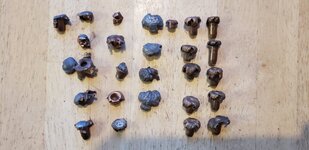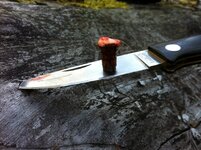As mentioned just above, it is interesting to me that some companies making monolithic bullets are attempting to improve bullet performance by designing monolithic bullets to come apart, rather than stay together like this.
For the record, I don't have dog in this fight as far as one bullet "working well" and another not. I've used all kinds of bullets, and to me, they all work in different ways; I could make a Pros/Cons chart for every one of them. Use whatever you think is best for your particular cartridge and situation.
All these came out of dead animals and no rodeos related to "bullet performance" that I can recall. A couple even managed to kill just fine with jacket/core separation. In those cases "bullet failure" never even remotely entered my mind. To me, core/jacket separation is about as non-issue as non-issue can be. I just don't see the problem other than it makes for a crappy bullet picture.
View attachment 965989


